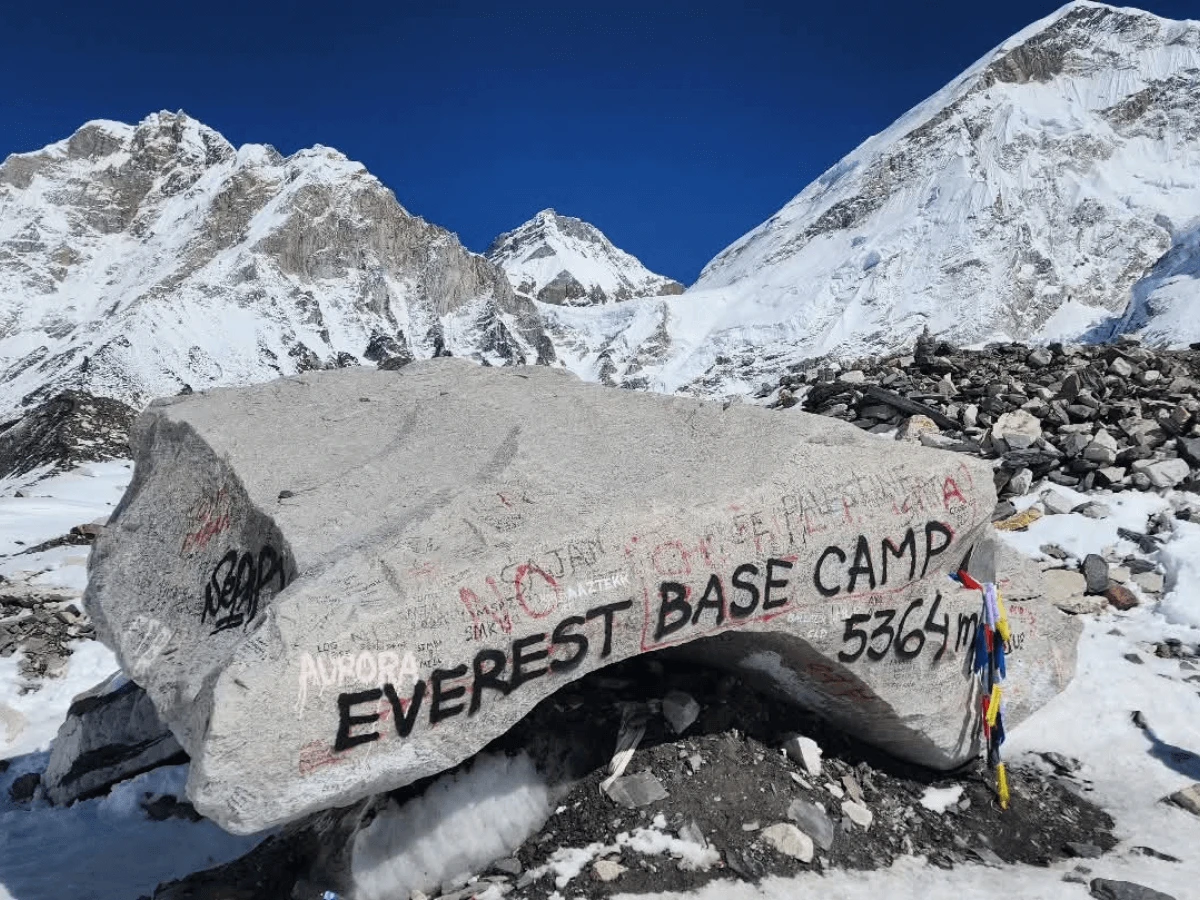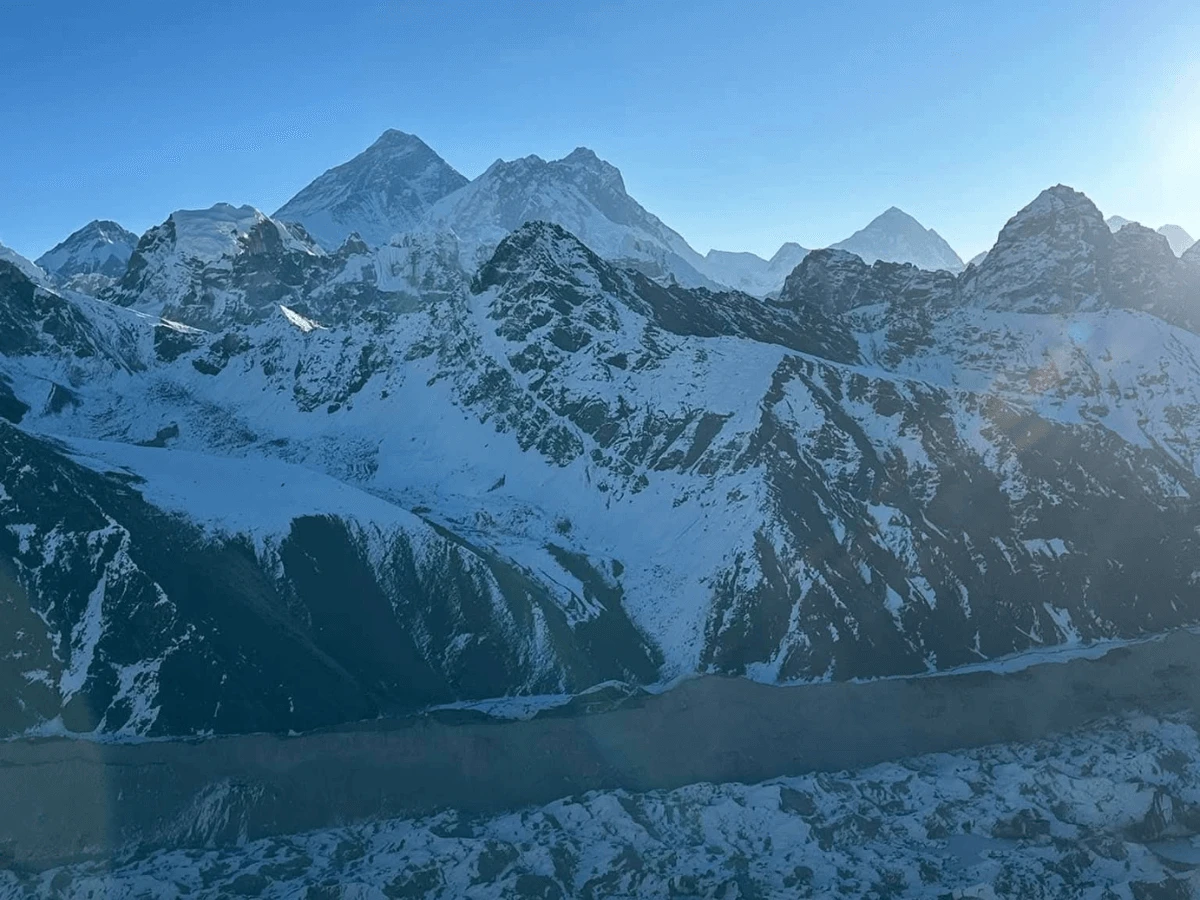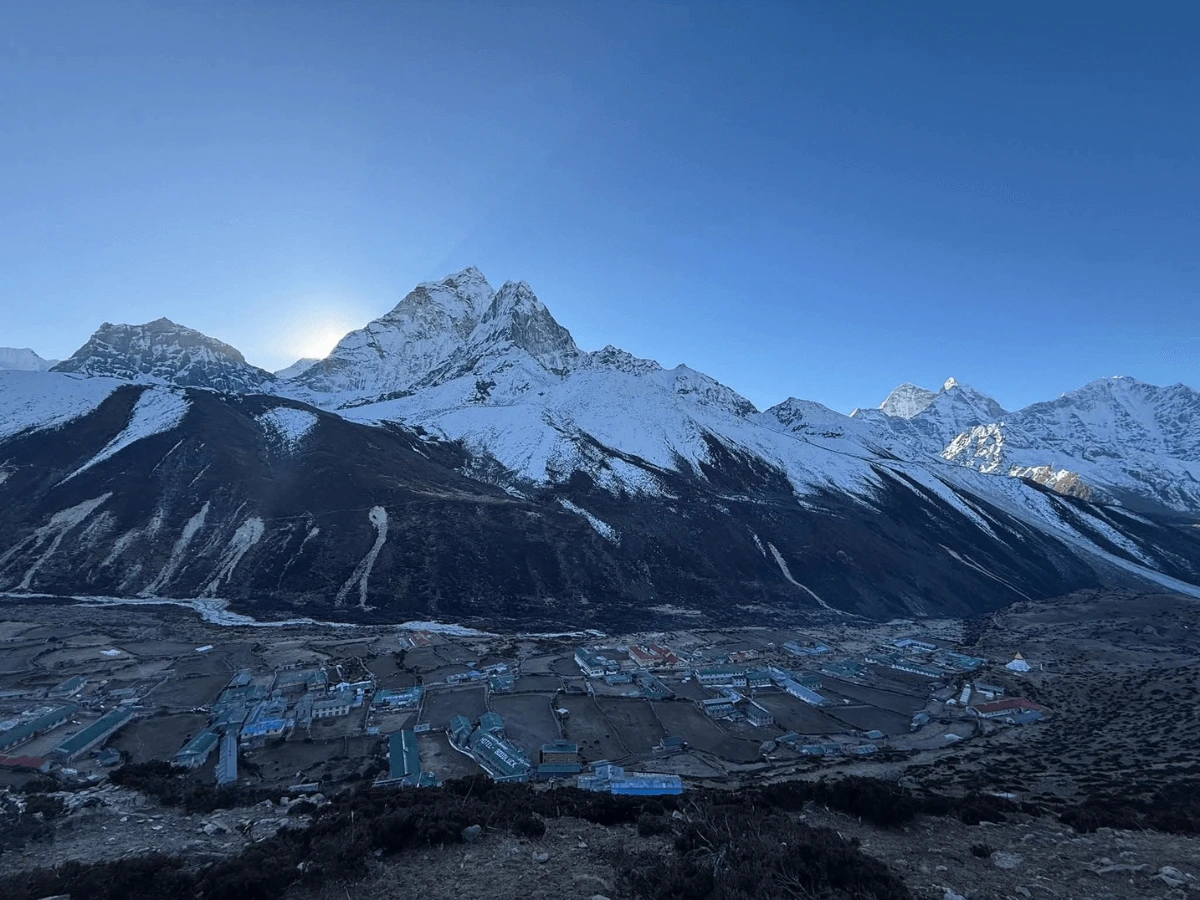The Everest Gokyo Valley Trek is a classic adventure that combines the classic Everest Base Camp route with a detour into the tranquil Gokyo Valley. This journey offers the best of both worlds: the famous Mount Everest Base Camp Trek 14 Days and the off-the-beaten-path beauty of Gokyo Lakes. Embark on the Sagarmatha National Park, a UNESCO World Heritage Site renowned for its dramatic peaks, rich Sherpa culture, and unique high-altitude ecosystems. Trek through the raging Dudhkoshi rivers and over swaying suspension bridges, ascend through rhododendron forests.
The trip to EBC and Gokyo Valley begins with the Kathmandu to Lukla Flight. Next, the trek follows Dudh Koshi River up to Namche Bazaar (3,440 m), the bustling Sherpa town where trekkers acclimatise and catch their first views of Everest.
From Namche, trekkers follow the less-crowded trekking route in Everest to Gokyo Valley. After soaking in the awe-inspiring views from Gokyo Ri (5,357 m), you traverse eastward over Cho La Pass to Eerest Base Camp. The grand finale is stepping into Everest Base Camp itself and then climbing Kala Patthar (5,545 m) for a breathtaking sunrise over Everest. Throughout the journey, you’ll be surrounded by 8,000-meter giants likeEverest, Lhotse, Makalu, and Cho Oyu, creating memories that will last a lifetime. After exploring the Everest Base Camp, the trip drops down to Namche via Pheriche and ends at Lukla.
The Everest Gokyo Valley Trek is considered a challenging trek suitable for seasoned trekkers or very fit beginners. It involves 5 to 7 hours of walking per day on rugged mountain terrain, with significant altitude gains. The classic Everest Base Camp trek is rated as moderate; however, adding the Gokyo Valley and a high pass crossing increases the challenge. Proper acclimatisation is incorporated into the itinerary to help prevent altitude sickness, but trekkers must be prepared for cold nights and thin air at high elevations.
With determination, adequate preparation, and guidance from our experienced Mountain Eco Trails guides, the rewards of this trek are truly unparalleled—from quieter trails in Gokyo to the iconic achievement of reaching Everest Base Camp.
Why do the Gokyo Valley Trek and the Everest Base Camp at the same time?
If you have the time and adventurous spirit, combining the Gokyo Valley trek with the Everest Base Camp route is highly rewarding. Doing both in one journey allows you to experience more of the Everest region without needing to plan a separate trip. Here are a few compelling reasons to tackle the two treks together:
- Two best treks in the Everest region: The Gokyo Valley Trek or Gokyo Lake Trek is a spectacular adventure to the turquoise lakes and Gokyo Ri summit. Meanwhile, the Everest Base Camp Trek is the famed pilgrimage to the foot of Mount Everest.
- Diverse Landscapes and Views: The combined Gokyo and EBC trek provides a richer range of landscapes. You’ll witness the emerald waters of the Gokyo Lakes with reflections of Cho Oyu (8,188 m) and other peaks, a glacier and a high pass to enter the Khumbu Valley.
- Fewer Crowds in Gokyo: The Everest Base Camp trail is popular and can be busy in peak seasons, but the Gokyo Valley is comparatively less crowded.
- Greater Sense of Accomplishment: Completing either trek is an achievement, but conquering both the Gokyo Ri hike and the Everest Base Camp trek in one go is truly special.
In summary, tackling the Gokyo Valley and Everest Base Camp together means a more comprehensive Everest adventure. You efficiently use your trekking days to cover two iconic routes, ensuring that you don’t miss out on any major highlights of the region. For slightly extra effort, you are rewarded with extra dimensions of scenery, culture, and personal triumph.
Explore Gokyo Valley, Gokyo Lakes, and Hike Gokyo Ri
The Gokyo Valley Trek is one of the best treks in the Everest Region. From Namche Bazaar, the trail splits from the regular Everest Base Camp Trek route and passes through small Sherpa settlements like Dole and Machhermo. Along the trail, enjoy the views of Cholatse and Taboche in the distance. Upon reaching Gokyo village (4,790 m) on the shore of the third lake, you are greeted by an astonishing vista: turquoise-blue lakes set amid a rugged moonscape of ice and rock, with Cho Oyu looming at the end of Gokyo Valley.
The Gokyo Lakes are a system of six main glacial lakes, revered as sacred by both Buddhists and Hindus. Thonak Tsho (Fourth Lake) and Ngozumpa Tsho (Fifth Lake) lie further north of the main settlement and can be visited if you have an extra day. In the clear morning light, the lakes mirror the surrounding snow-dusted mountains, creating picture-perfect scenes. It’s common to see prayer flags fluttering by the lakeshore and perhaps a pair of Brahminy ducks paddling on the water’s surface, adding to the tranquil atmosphere.
A key highlight of this valley is the Gokyo Ri Hike. Starting early from Gokyo, you’ll ascend a steep trail to the summit of Gokyo Ri at 5,357 m. The Gokyo Ri hike difficulty is moderate to challenging – it’s a tough climb at high altitude, gaining about 600 meters and taking 2–3 hours. At the top, you are rewarded with one of the most panoramic views in the Himalayas. On a clear day, you can see four 8,000-meter giants: Mount Everest (8,849 m) peaking over the ridge of Nuptse, Lhotse (8,516 m) immediately to Everest’s south, Makalu (8,485 m) further to the east, and the hulking Cho Oyu (8,188 m) to the north near Tibet.
Cross-enchanted Cho La Pass from Gokyo to Everest Base Camp
The link between Gokyo and the Everest Base Camp trail is the crossing of Cho La Pass – a challenging and enchanting high mountain pass. Cho La (5420 m / 17,782 ft) is one of the three great passes of the Everest region. Also, trekkers cross this pass while doing the Everest Three High Pass Trek.
From Gokyo, you’ll first trek to Dragnag (Thagnak), a simple settlement at the foot of the pass. From here, trekkers will climb through the zigzag, steep, rocky trails and possibly over some snow depending on the season. The terrain is rugged – sections of the trail may involve walking on rock scree or a small glacier. With patience and careful footing, you reach the prayer-flag-adorned summit of Cho La Pass, where the world seems to open up around you. The top of the pass delivers breathtaking views of the valley, glaciers and peaks.
The descent from Cho La on the eastern side is steep at first, requiring careful steps down boulders and across an icy path next to a small glacier. You will reach Lobuche via Dzongle after descending from the Cho La Pass. The trek from Lobuche continues to Everest Base Camp.
Gokyo to Everest Base Camp
Rejoining the main route at Lobuche, you now set your sights on the ultimate goal: Mount Everest Base Camp. Over the next day or two, you will trek in the footsteps of countless climbers and adventurers towards the base camp of the world’s highest peak. The trail from Lobuche (4,910 m) to Gorak Shep (5,164 m) is a gradual ascent across the rocky moraine of the Khumbu Glacier. At Gorak Shep, you will take a break and Hike to Everest Base Camp, a lifetime achievement.
Trekking to Everest Base Camp (5,364 m) from Gorak Shep takes you alongside the Khumbu Glacier. The trail rises and falls over glacial debris; you’ll hop across small streams and tread carefully on the rocky terrain. Colourful prayer flags and cairns start to appear, marking the route to this sacred goal. Finally, as you crest one more rise, you’ll see the expanse of Everest Base Camp spread out on the glacier ahead. Take your photos by the Everest Base Camp marker rock, savour the achievement, and reflect on the journey that brought you here.
While hiking to EBC is one of the highlights of this trek, the adventure isn’t quite over yet. The following morning, hike to Kala Patthar (5,545 m), a black rocky hill above Gorak Shep, to catch the sunrise on Mount Everest. This hike is steep and demanding, but it provides the most iconic view of Everest, Lhotse and Nuptse forming a dramatic wall, Pumori immediately to the west, and down below the tiny dots of Gorak Shep and the Khumbu Glacier.
15-Day Everest Base Camp with Gokyo Valley Trek Cost 2026,2027
The cost of the 15-Day Everest Base Camp with Gokyo Valley trek can vary based on the services included and the size of your group. For 2026, 2027, an all-inclusive package for this combined trek generally ranges from about $1,600 to $2,000 per person. Mountain Eco Trails offers this trek at around $1,799 per person (with group discounts available for larger groups), which falls in line with industry standards for a guided, all-inclusive trek. The Everest Gokyo Valley Trek cost covers guide fee, domestic airfare, meals, accommodation, permits, and other operational costs. Mountain Eco Trails prides itself on transparent pricing – the package price is comprehensive with no hidden fees, and we provide quality services to ensure you get the best value for your money.
Why choose Mountain Eco Trails for the trek to the Everest Region?
Choosing the right trekking company can make a huge difference in your overall experience. Here’s why Mountain Eco Trails is an excellent choice for your Everest Gokyo Valley Trek:
- Experienced crew members and official team.
- Flexible and customised Langtang Trek Itinerary with personalised service.
- Complimentary Services like Duffel Bag, Trekking Poles, SIM Card, and an hour trekker's massage
- First Aid Kit with basic medication.
- Hassle-free last-minute booking and trip arrangements.
- Competitive and Fair price that matches the services and has no hidden costs.
- Special Discount for a group of trekkers of more than 5 Pax
When you choose Mountain Eco Trails, you’re choosing a company who are passionate about the Himalayas and loves sharing them with trekkers from around the world. Your success and smile at the end of the trek are our greatest rewards. Let us show you the magic of the Everest region in a way that is safe, immersive, and truly memorable. For more details, feel free to contact us via email or WhatsApp at +9779849790153.






